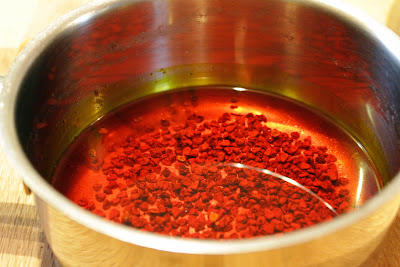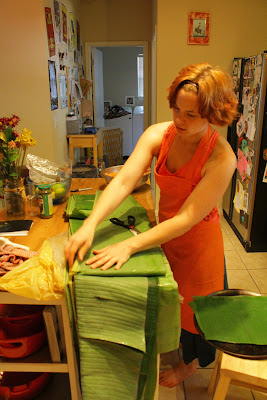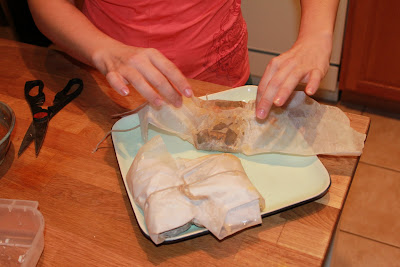After (another) unplanned hiatus - this time three weeks! - I decided to come back big. I tackled pasteles, a kind of Puerto Rican tamale, which my friend Rachel requested I make a couple of months ago. I was slow getting to it, but I blame my sister-in-law for inducing me to read the Fire and Ice Chronicles (Game of Thrones series) which occupied my time completely for the first 6 weeks I was in Austin. There were days I didn't even leave the house because I couldn't stand to put the books down for more than 20 minutes. People asked me what I thought of Austin so far and I could tell them what I thought of the Starks and Westeros. Then there's that pesky "job search" thing. I don't know how many hours I've spent searching and applying for jobs, but the result of the effort is still lacking. Austin is a great city for live music, the software industry and the University of Texas - outside of that it's a bit of a struggle! So what I'm trying to say is, I haven't cared much about cooking for the past few weeks - but now I'm back.
And I think I need to start tackling easier (read: less time-intensive) recipes. Not that pasteles aren't worth the effort - they are super delicious - I no longer feel justified in spending an entire day making one dish. I once again learned to trust Seth in some things, such as when he told me it can take a day (or more) to make tamales, so did I know what I was getting myself into? Haha, I do now. Am I glad I made the effort? Hell's yeah! Pasteles are delicious and the masa, made of a combination of yucca, taro, green banana, plantain, potato AND pumpkin, is moist and slightly sweet, both a refreshing change if you've only tasted corn masa and a nice foil to the stewed pork it encloses. Seth and I ate our first few straight from the pot, then discovered that allowing the pasteles to rest for several hours (allowing the meat and masa to meld their flavors) makes them amazing. It's not difficult to understand why these are such a special treat.
I made a few adjustments to the recipe and, despite the fantastic end result, would make more if I ever tackle this again. First, I ended up with almost half the masa remaining after making my pasteles so I would reduce the masa ingredient by at least 1/3, if not a total half (I've done this for you already!) Also, the original recipe called 1/2 cup annato oil and 6 tablespoons achiote, which it described as "annato oil". What? Goya sells achiote paste which I mixed with 1/2 cup water and used in the masa. It tasted good so I think I made the right choice. I also recommend refrigerating for a couple of hours so it doesn't goosh all over the place when folding the pasteles. Finally, I have mixed feelings about the banana leaves: they impart a distinct flavor but are an ass to work with and I had to wrap everything with parchment paper because the leaves kept splitting, even after softening them up in the oven. Meh, who knows what the future will bring?
Pasteles*
from Puerto Rican Recipes, modified
makes about 24 pasteles
| The Masa (the dough): 6 green bananas (Chiquita Style) 11 green plantains (Big Bananas) 1 1/2 lbs. yautias (Taro Root) 1 medium potato 1 lb. pumpkin (Calabaza) 2 lbs. yuca (Cassava) 6 tbsp. achiote (annatto oil) 1/2 c. annatto oil 5 tbsp. salt, to taste 1 c. pork stuffing sauce (this is the liquid from the pork you cook for the filling) The Pork Stuffing: 3 1/2 lbs. pork shoulder, cut into small pieces (about 1-inch) 1 medium, chopped fine 3 cloves garlic, finely minced 1 green pepper, chopped 3 1/2 tbsp. recaito 8oz chopped tomatoes (I used canned, but you fresh if you have it) 1 jalapeno or serrano, chopped (optional, if you want it spicy) 2 1/2 c. water 2 tsp. salt 1/4 tsp. black pepper 2 envelopes of sazon with annatto (achiote) Extra Materials: 1 roll butchers twine (Chiranga Style) 1 lb. parchment paper 1 pack banana leaves |
| 1. Heat a small amount of oil in a Dutch oven (or large pot) and saute onion, garlic and green pepper (and jalapenos, if using) for a few minutes, then add meat and cook until pork is browned, about 5 minutes. Add recaito, tomatoes, water, salt, black pepper and sazon into a large pot. Bring to a boil then simmer for 45 minutes, then set aside to cool. Set 1 cup of liquid aside for the masa. 2. Peel and cut all of the Rican roots and veggies into small pieces, placing chopped pieces in a bowl with salted water to keep them from browning. Keep the veggies in the salted water while pork cooks. 3. When pork has cooled to room temperature, drain all the Rican roots and vegetables and chop them in the food processor. If you need to lubricate the vegetables at all (so that chop better without burning out your foop's motor) use some of the reserved pork stew liquid or achiote. The resulting mixture should have the texture of oatmeal. 4. Put veggie mixture in a large bowl and add any remaining pork liquid and achiote, plus the salt and pepper. Mix well and taste for salt (adding more if needed.) You can refrigerate the masa at this point if you think it is too loose; otherwise, continue to the next step. 5. Wash and wipe the banana leaves dry, then cut into 1-foot square pieces. If using parchment paper (you probably will be!) cut the squares into 14in-square pieces. To make the leaves easier to work with heat in a 350F oven for a few minutes. Cut the twine about 36 inches long so you can wrap 2 pasteles together. 6. Place a piece of banana leave in the center of a piece of parchment paper. If you were not lucky enough to find banana leaves, use only the parchment paper. Smear about 1/2 teaspoon of annatto oil in the center of the banana leaf and place 1/2 to 3/4 cup of the masa in the center of the banana leaf, smearing around in a circular motion. Place 1/4 cup of the pork stuffing with a little sauce in the center. 7. Fold the banana leaf around the filling as you would wrap a burrito. Wrap parchment around the banana leaf packet. Tie two pasteles together with twine and continue in this manner until the pork stuffing is finished. 8. Fill a large deep pot with water leaving enough space to add the pasteles. Bring the water to a boil then add salt so that when you taste the water, you can taste the salt. Immerse the pasteles in the boiling water and boil at medium heat for 1 1/2 hours. Make sure the pasteles are immersed in water while boiling. If not add more hot water to the pot. If after 1 1/2 hours they are not fully cooked (the masa will fall apart if this is the case) just cook them for another 30 minutes. 9. Allow them to drain then untie and EAT! You can either eat them them right away or allow the flavors to meld for several hours- even overnight! Thank you, Rachel, for introducing them to me as they are delicious! Enjoy :) * - I hope this recipe doesn't read too convoluted. It has taken me five days to post this challenge. |










Awww I'm so happy you made um... You're a pro! I knew you'd rock it ;)
ReplyDelete-RACHEL
I was so happy to find this recipe. I found a recipe using only malanga (yauita) and green bananas which is all I used but I used your filing ingredients and loved the banana leaves (goya frozen worked great) but next time Im making your masa dough to see the difference loved it so much. You had great tips to make this complicated recipe that was well worth the effort. it gave me back my puerto rican roots.
ReplyDelete